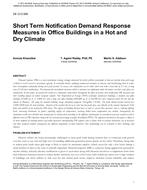
DE-13-C006 — Short Term Notification Demand Response Measures in Office Buildings in a Hot and Dry Climate
- Comments Off on DE-13-C006 — Short Term Notification Demand Response Measures in Office Buildings in a Hot and Dry Climate
- ASHRAE
Demand response (DR) is a load curtailment strategy strongly advocated by electric utilities nationwide to tide over periods when grid usage is likely to reach/exceed its maximum capacity. It essentially involves notifying commercial customers in advance and incentivizing them to reduce their consumption voluntarily during such peak periods. In essence, this notification can be either short term with a lead time of 2-3 hrs, or long term (12-24 hour notification). The demand-side curtailment measures which a customer can implement under the former are fewer and, often, not transparent. In this paper, we present the results of a simulation study which investigated the effect of various short notification DR measures and their resulting impact on indoor occupant comfort. Two Department of Energy (DOE) prototype commercial buildings, a medium size office building (53,600 sq. ft. or 5,000 m²) and a large size office building (498,600 sq. ft. or 46,300 m²) were simulated under the hot and dry climate of Phoenix, AZ using the detailed building energy simulation program, EnergyPlus V6.0.0. The peak diurnal period selected was 12:00-18:00 hours (6 hour window). Analysis of the weather file led us to select two hot peak days, one reflective of the summer high-peak (15th July) and another of the mid-peak (29th June). The impact of building thermal mass as well as several other measures such as reducing lighting levels, increasing thermostat set points, adjusting supply air temperature, resetting chilled water temperature was studied. Subsequently the simulation results were distilled and summarized in tabular form according to the different combinations of curtailment measures needed to achieve different levels of DR reductions along with the associated percentage of people dissatisfied (PPD). The approach described in this paper is likely to be better adopted by building owners and utility operators contemplating DR response since it allows them to evaluate alternative sets of measures and their occupant comfort consequences for different magnitudes of load reduction. This methodology can be extended to other buildings and climates.
Citation: ASHRAE Conference Papers, Denver, CO
Product Details
- Published:
- 2013
- Number of Pages:
- 8
- File Size:
- 1 file , 1.5 MB
- Product Code(s):
- D-DE-13-C006

